
Stavanger Cathedral is Norway's oldest cathedral and the seat of the Bishop of Stavanger who leads the Diocese of Stavanger in the Church of Norway. It is located in the centre of the city of Stavanger which lies in the southwestern part of the large Stavanger Municipality in central Rogaland county, Norway. The church is situated in the centre of the city, in the borough of Storhaug between Breiavatnet in the south, the square with Vågen in the north west, the cathedral square in the north, and Kongsgård in the southwest.
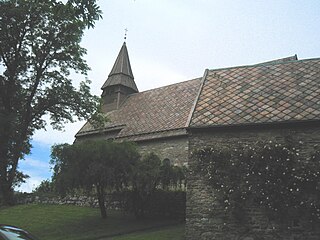
Fana Church is a parish church of the Church of Norway in Bergen Municipality in Vestland county, Norway. It is located in Fanahammeren, a village in the borough of Fana in the city of Bergen. It is one of the two churches for the Fana parish which is part of the Fana prosti (deanery) in the Diocese of Bjørgvin. The gray, stone church was built in a long church design in the year 1153 using plans drawn up by an unknown architect. The church seats about 450 people. The existing stone building celebrated its 850-year anniversary in 2003, but the church building history is long and complicated. Historians assert that the church has been rebuilt and enlarged several times.

Holy Cross Church is a special parish church in Bergen municipality in Vestland county, Norway. It is situated in the centre of the city of Bergen, just east of the head of the Vågen bay. The church is located at the intersection of the streets Kong Oscars gate and Nedre Korskirkeallmenningen. It is one of the churches for the Bergen domprosti parish which is part of the Bergen domprosti (arch-deanery) in the Diocese of Bjørgvin. The large stone church was built in a cruciform design around the year 1150 using plans drawn up by an unknown architect. The church seats about 600 people.

Bergen Cathedral is a cathedral in the city of Bergen in Vestland county, Norway. It is the episcopal seat of the Diocese of Bjørgvin as well as the seat of the "Bergen domkirke" parish and the seat of the Bergen domprosti (arch-deanery). It is part of the Church of Norway. The first recorded historical reference to this church is dated 1181. It retains its ancient dedication to Saint Olaf. The cathedral seats about 900 people.

St Mary's Church is a parish church of the Church of Norway in Bergen Municipality in Vestland county, Norway. It is located in the Bryggen area in the central part of the city of Bergen. It is one of the churches for the Bergen Cathedral parish which is part of the Bergen domprosti (arch-deanery) in the Diocese of Bjørgvin. The large, gray stone church was built in a long church design using plans drawn up by an unknown architect. The church seats about 240 people. The construction of the church is believed to have started in the 1130s or 1140s and completed around 1180, making this church the oldest remaining building in the whole city of Bergen. There have been a few fires that burned the church, as well as several renovations and reconstructions, most recently in 2013.

Strandgaten is a street in the city centre of Bergen, Norway, west of the bay of Vågen. It starts at Torgallmenningen and follows the eastern shore of the Nordnes peninsula to Tidemands gate, where it becomes Nordnesgaten. The easternmost quarter of Strandgaten is a regular two-way street, while it is an eastbound one-way street between Tollbodallmenningen and Holbergsallmenningen, and between Østre Murallmenningen and Torgallmenningen. Between Holbergsallmenningen and Østre Murallmenningen the street is pedestrianised. In total, Strandgaten is approximately 1.2 km long.

Ørland Church is a parish church of the Church of Norway in Ørland municipality in Trøndelag county, Norway. It is located in the town of Brekstad, along the Trondheimsfjorden. It is one of the churches for the Ørland parish which is part of the Fosen prosti (deanery) in the Diocese of Nidaros. The white, stone church was built in a long church style during the 12th century. The church seats about 330 people.

Ranem Church is a parish church of the Church of Norway in Overhalla Municipality in Trøndelag county, Norway. It is located in the village of Ranemsletta. It is the church for the Ranem parish which is part of the Namdal prosti (deanery) in the Diocese of Nidaros. The medieval era, marble and stone church was built in a long church design in the mid-12th century using plans drawn up by an unknown architect. The church seats about 200 people.
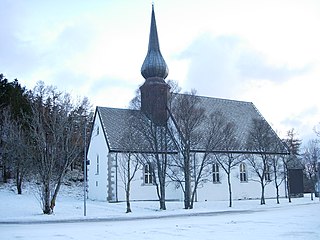
Bodin Church is a parish church of the Church of Norway in Bodø Municipality in Nordland county, Norway. It is located in the southeastern part of the town of Bodø. It is one of the churches for the Bodin parish which is part of the Bodø domprosti (deanery) in the Diocese of Sør-Hålogaland. The white, stone church was built in a long church style around the year 1240 using plans drawn up by an unknown architect. The church seats about 300 people.
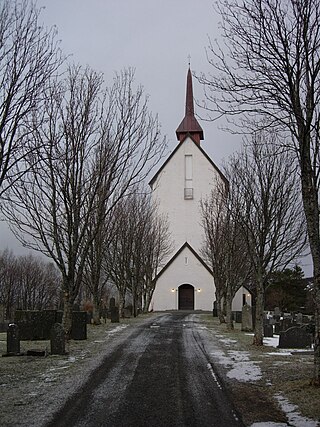
Skjerstad Church is a parish church of the Church of Norway in Bodø Municipality in Nordland county, Norway. It is located in the village of Skjerstad, along Skjerstadfjorden. It is one of two churches for the Misvær og Skjerstad parish which is part of the Bodø domprosti (deanery) in the Diocese of Sør-Hålogaland. The white, stone and concrete church was built in a long church style in 1959 using plans drawn up by the architect Arnstein Arneberg. The church seats about 500 people.
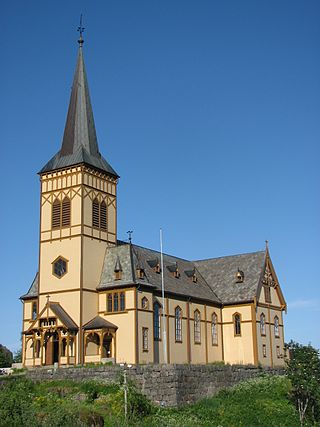
Vågan Church is a parish church of the Church of Norway in Vågan Municipality in Nordland county, Norway. It is located in the village of Kabelvåg on the island of Austvågøya. It is the church for the Vågan parish which is part of the Lofoten prosti (deanery) in the Diocese of Sør-Hålogaland. The yellow, wooden church was built in a cruciform style in 1898 using plans drawn up by the architect Carl J. Bergstrøm. The church seats about 1,200 people, making it the largest wooden building in Northern Norway, hence the nickname Lofoten Cathedral.
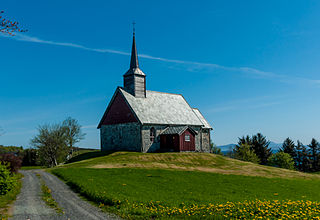
Old Edøy Church is a historic parish church of the Church of Norway in Smøla Municipality in Møre og Romsdal county, Norway. It is located on the southwestern end of the small island of Edøya, just south of the larger island of Smøla. Prior to the construction of the new Edøy Church in 1885, it was the main church for the Edøy parish which is part of the Ytre Nordmøre prosti (deanery) in the Diocese of Møre. The stone church was built in a long church style around the year 1190 by an unknown architect. The church seats about 120 people.

Herøy Church is a parish church of the Church of Norway in the municipality of Herøy in Møre og Romsdal county, Norway. It is located in the town of Fosnavåg, on the island of Bergsøya. It is the church for the Herøy parish which is part of the Søre Sunnmøre prosti (deanery) in the Diocese of Møre. The white, concrete church was built in a rectangular style in 2002 by the architects Kine Tambs and Hans Petter Madsø from an architecture firm from Trondheim. The church seats about 700 people.

Gjerpen Church is a parish church of the Church of Norway in Skien Municipality in Telemark county, Norway. It is located in the town of Skien. It is one of the churches for the Gjerpen parish which is part of the Skien prosti (deanery) in the Diocese of Agder og Telemark. The tan, stone church was built in a cruciform design around the year 1153 using plans drawn up by an unknown architect. The church seats about 485 people.

Kinn Church is a parish church of the Church of Norway in Kinn Municipality in Vestland county, Norway. It is located on the small island of Kinn. It is one of two churches for the Kinn parish which is part of the Sunnfjord prosti (deanery) in the Diocese of Bjørgvin. The white, stone church was built in a long church design in the middle of the 12th century using plans drawn up by an unknown architect.

Manger Church is a parish church of the Church of Norway in Alver Municipality in Vestland county, Norway. It is located in the village of Manger on the island of Radøy. It is one of the four churches in the Radøy parish which is part of the Nordhordland prosti (deanery) in the Diocese of Bjørgvin. The white, wooden church was built in a long church style in 1891 using designs by the architect Hans Heinrich Jess who was from Bergen. The church seats about 440 people.

Strusshamn Church is a parish church of the Church of Norway in Askøy Municipality in Vestland county, Norway. It is located in the village of Strusshamn. It is the church for the Strusshamn parish which is part of the Vesthordland prosti (deanery) in the Diocese of Bjørgvin. The large concrete and glass church was built in a fan-shaped design in 1969 using plans drawn up by the architects Torgeir Alvsaker and Einar Vaardal-Lunde. The church seats about 500 people.

Stange Church is a parish church of the Church of Norway in Stange Municipality in Innlandet county, Norway. It is located about 2 kilometres (1.2 mi) west of the village of Stangebyen. It is the church for the Stange parish which is part of the Hamar domprosti (deanery) in the Diocese of Hamar. The white, stone church was built in a partial cruciform design in the middle of the 13th century using plans drawn up by an unknown architect. The church seats about 400 people.
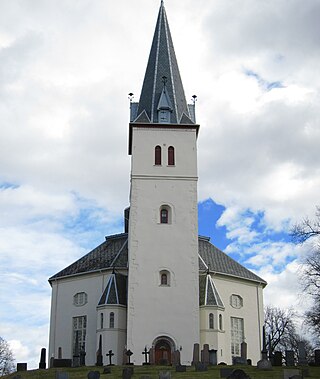
Vang Church is a parish church of the Church of Norway in Hamar Municipality in Innlandet county, Norway. It is located in the village of Ridabu. It is one of the churches for the Vang parish which is part of the Hamar domprosti (deanery) in the Diocese of Hamar. The white, stone church was built in a octagonal design in 1810 using plans drawn up by the architect Abraham Pihl. The church seats about 1,000 people.
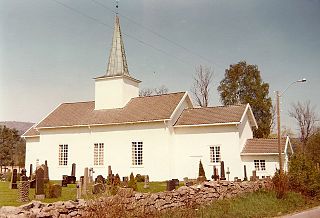
Svarstad Church is a parish church of the Church of Norway in Larvik Municipality in Vestfold county, Norway. It is located in the village of Svarstad. It is one of the churches for the Lardal parish which is part of the Larvik prosti (deanery) in the Diocese of Tunsberg. The white, wooden church was built in a long church design in 1657 using plans drawn up by an unknown architect. The church seats about 220 people.



























